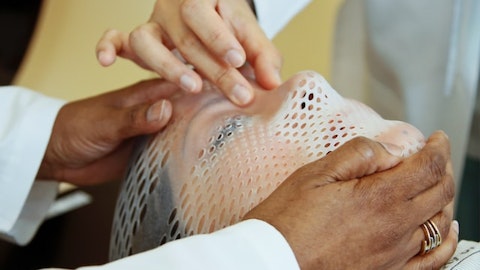Accuray Incorporated (NASDAQ:ARAY) Q2 2024 Earnings Call Transcript January 31, 2024
Accuray Incorporated isn’t one of the 30 most popular stocks among hedge funds at the end of the third quarter (see the details here).
Operator: Good day, and welcome to the Accuray Second Quarter Fiscal 2024 Financial Results. All participants will be in listen-only mode. [Operator Instructions] After today’s presentation, there will be an opportunity to ask questions. [Operator Instructions] Please note, this event is being recorded. I would now like to turn the conference over to Jesse Chew, Senior Vice President, Chief Legal Officer. Please go ahead.
Jesse Chew: Thank you, operator, and good afternoon, everyone. Welcome to Accuray’s conference call to review financial results for the second quarter of fiscal year 2024, which ended December 31, 2023. During our call this afternoon, management will review recent corporate developments. Joining us on today’s call are Suzanne Winter, Accuray’s President and Chief Executive Officer; and Ali Pervaiz, Accuray’s Chief Financial Officer. Before we begin, I would like to remind you that our call today includes forward-looking statements. Actual results may differ materially from those contemplated or implied by these forward-looking statements. Factors that could cause these results to differ materially are outlined in the press release we issued just after the market close this afternoon as well as in our filings with the Securities and Exchange Commission.
We based the forward-looking statements on this call on the information available to us as of today’s date. We assume no obligation to update any forward-looking statements as a result of new information or future events, except to the extent required by applicable securities laws. Accordingly, you should not put undue reliance on any forward-looking statements. A few housekeeping items for today’s call. First, during the Q&A session, we request that participants limit themselves to two questions and then re-queue with any follow-ups. Second, all references to a specific quarter in the prepared remarks are to our fiscal year quarters. For example, statements regarding our second quarter refer to our fiscal second quarter ended December 31, 2023.
Additionally, there will be a supplemental slide deck to accompany this call, which you can access by going directly to Accuray’s Investor Relations page at investors.accuray.com. With that, let me turn the call over to Accuray’s Chief Executive Officer, Suzanne Winter. Suzanne?
Suzanne Winter: Thank you, Jesse. Good afternoon, and thank you all for joining the call. Accuray delivered another strong quarter with outstanding order growth, driven by our new product introductions and both top and bottom line performance, consistent with our expectations for the first-half. Before I get into the details of the quarter, I want to highlight a few key points from the 3-year outlook we introduced at our ASTRO Investor Day in October. These include driving revenue growth through innovation to advanced care, broadening our product portfolio to compete in the global value segment, accelerating growth in our recurring service solutions business and improving profitability while strengthening our balance sheet. I’m proud to say that in the first-half of FY ’24, we have made good progress on each of these strategic pillars and advanced significant growth catalysts that will be realized in the coming quarters.
We believe new product launches like VitalHold for the Radixact, Tomo C in China, Helix, our Helical value segment product and Cenos, online adaptive capability will be growth catalysts and begin to accelerate revenue and profitability growth in Q4 and into FY ’25 and beyond. Reflecting on Q2, I am extremely pleased with order performance, which at $94 million represents 19% year-over-year growth and a very strong book-to-bill ratio of 1.8. We believe 1.2 book-to-bill ratio is a healthy target. So at 1.8, we are very pleased with these results, which were driven by customer adoption of our new product innovation and high-impact commercial strategies. We received Shonin market clearance for VitalHold in Japan with a full introduction at the Japanese Society for Radiation Oncology Conference where we received seven orders at the close of the conference.
VitalHold enhances breast cancer treatment by enabling surface-guided therapy designed to protect the heart and lungs and as a result of our joint development with C-RAD. We believe this will further strengthen our number two market share position in Japan. Additionally, we are advancing progress on gaining market clearance for Cenos online adaptive capabilities on our precision treatment planning solution. This clearance is expected in the second half of the fiscal year for the U.S. market and we believe it will enhance our competitive win rate and allow us to build our order backlog for trade-in, trade-up replacements and upgrades for our installed base of Radixact Systems. Cenos leverages AI technology and is a result of our partnership with Limbus AI, and we are encouraged by continued customer interest since ASTRO.
We believe it will help drive higher competitive win rates and installed base growth to the Radixact platform. Now turning to our Tomo C system in China. Q2 was our first quarter since regulatory approval to market the system in China and was an important indicator of customer response. We saw overall 44% year-over-year order growth in the China region within the quarter. And while this partially represents some pent-up demand for Tomo C, we expect order activity to continue to be strong towards fiscal year-end with revenue and margin growth beginning in Q4 and into FY ’25 pending customer installation timing. As a reminder, Tomo C expands our portfolio in China with a domestic-made product and enhances our access into the Type B market, which represents approximately $600 million annually over the next five years.
Additionally, our Q2 performance in service was outstanding with 8% revenue growth year-over-year. As we have discussed, the service business is a strategic area of focus for the company, and each service contract represents a recurring revenue stream over the 10 to 12-year life of the system after the warranty period. Although we remain in the early innings of our service transformation, I am very pleased to see impact from the strategic actions we put in place to improve commercial performance and enhance our offerings. Finally, Q2 global demand for installation was strong, and we ended the quarter with 6% growth year-over-year in our global installed base of systems. This was led by the APAC region, which celebrated the milestone of 250 systems installed and remains one of our fastest-growing installed base regions at 13% year-over-year growth.
As we look at our business model going forward, we see installed base growth as a leading performance indicator and the primary driver behind future service contract revenue. As service revenue grows, we expect to benefit from scale and see a significant bottom line impact from improving margins. From a region perspective, the EIMEA region continues its outstanding performance in both orders and revenue with 30% and 11% growth year-over-year, respectively. The APAC region had 42% order growth year-over-year, with China delivering 44% growth, reflecting strong demand. Revenue in APAC was impacted in Q2, primarily due to customer tender timing in Australia and Taiwan, which resulted in APAC revenues being down 8% year-over-year. We expect this to resolve by our fiscal year-end, along with backlog conversion of new Tomo C orders in China to accelerate revenue recovery starting in late Q4.
Japan delivered positive order growth and on a constant currency basis was up 8% year-over-year. However, the negative impact of FX versus last year reduced actual order growth to 2.4%. Service revenue in the region grew by 10% on a constant currency basis, but total revenue was down 29% due to lower product shipments, which we expect will offset with higher volume in the second-half. On the positive side, the region continues to lead with key competitive wins at 50% of new orders coming from competitive replacements. The Americas region showed a strong sequential order growth of 72% from the prior quarter. This is the direct result of focused commercial strategies to help customers with value-added solutions to retain and grow the installed base.

In Q2, we saw longer customer installation time lines in the Americas region with revenues down 15% year-over-year, but we are encouraged by the strong 17% sequential quarterly revenue growth and are cautiously optimistic that conditions will improve over the coming quarters. Operationally, we are executing on our margin expansion plans. Ali will discuss our progress in greater detail as we’re seeing strong progress in the financial initiatives we laid out at the beginning of the year and at our Investor Day. Specifically, we’re seeing positive trends in pricing initiatives across our product and service solutions, a reduction in operating costs and lower service costs due to improved parts consumption. This has had a direct impact on service margin, which has improved by 160 basis points in the first-half of the year, compared to the same period last year and gives us a higher degree of confidence in our longer-term margin expansion plan.
Margin expansion remains a cultural transformation. And over the last 18 months, we have implemented new organizational structures with P&L accountability, new operating mechanisms to ensure we gain incremental price for our differentiated solutions, ensuring a faster and more predictable revenue cycle and continuing to drive cost efficiencies while increasing customer satisfaction value. I will now turn it over to Ali, who will speak more about our financial performance.
Ali Pervaiz: Thank you, Suzanne, and good afternoon, everyone. I want to begin by thanking our global employees and cross-functional teams, who continue to amaze us with their incredible work ethic and ability to execute on our strategy. Turning to the financials. Product growth orders for the second quarter were approximately $94 million, which is a 19% increase versus the prior year and 18% once adjusted for the impact of foreign exchange. This is the strongest order volume we’ve had in the last two fiscal years. And as Suzanne mentioned, it speaks to the market’s confidence in our products and new innovations. We’re proud of our commercial teams across the globe that were able to contribute to the strong result. This further strengthens our backlog and is a clear sign of the health and vitality of the future of our business.
This order intake represents a book-to-bill of 1.8, mostly driven by customer timing and improved pricing, which grew order margin rate by 8 points sequentially across our product portfolio. Net revenue for the second quarter was $107 million, which was up 3% sequentially and down 7% versus the prior year. Net revenue on a constant currency basis for the second quarter was $106 million, which represents an 8% decrease versus the prior year. Net revenue for the first half of the fiscal year is flat to the prior year. Service revenue for the quarter was $56 million, up 8% from the prior year and up 7% on a constant currency basis, primarily driven by an increase in contract revenue and higher installation, training and spare parts volume as expected.
This lift in service revenue exceeds our year-over-year installed base growth of 6%, illustrating that our pricing actions and our service contracts are now starting to be reflected in our P&L. Service revenue for the first-half of the fiscal year is 3% up versus prior year, driven by contract revenue, which was up 6% for the half. Product revenue for the second quarter was $52 million, down 19% from the prior year, driven by 6 fewer unit shipments versus last year. As discussed in our last earnings call, our revenue profile in fiscal year ’24 is more back-end loaded towards the second half, which is a result of the timing of our new product introductions. Product revenue for the first half of the fiscal year is down 3% versus the prior year.
Moving to the backlog. We ended the second quarter with a product order backlog of approximately $492 million, which represents greater than 2 years of FY ’23 product revenue. This reported backlog is up 1% sequentially and 4% lower than the prior year due to 19 orders representing $40 million that aged beyond 30 months, which we do not include in our reported backlog. In Q2, we had 3 orders that aged in for approximately $5 million and contributed to product revenue within the quarter. Finally, we had no order cancellations in the quarter. Our overall gross margin for the quarter was 33.5%, compared to 37.4% in the prior year. As you may recall, we experienced a onetime cost benefit in Q1 related to lower parts consumption due to the ERP implementation and expected it to offset in Q2 as reflected in our results.
Gross margin for the first-half was 35.7%, which was slightly below the first half of the prior year, mainly due to product mix. We expect gross margins to improve in the second half as we realize better service pricing along with the full benefit of restructuring actions taken in Q2. Operating expenses in the second quarter were $39.9 million, compared to $40.3 million in the prior year, down 1%. Excluding ERP implementation costs and severance payouts, operating expenses were down 8% to the prior year, illustrating continued cost discipline and focus on return on investment. Operating income for the quarter was negative $4 million compared to an operating gain of $2.7 million from the prior year due to lower standard margins, severance and ERP implementation costs.
Adjusted EBITDA for the quarter was $2 million compared to $8.5 million from the prior year. Adjusted EBITDA for the first-half of fiscal year ’24 was $8.5 million versus $10.4 million in the prior year with the decrease mainly driven by lower product volume. We expect adjusted EBITDA to grow in the second half with the full benefit of the restructuring actions taken in Q2 along with higher product revenue volume. We described the reconciliation between GAAP net income and adjusted EBITDA in our earnings release issued today. Turning to the balance sheet. Total cash, cash equivalents and short-term restricted cash amounted to $73 million compared to $77 million at the end of last quarter. Net accounts receivable were approximately $77 million, flat to the prior quarter.
We are very pleased with the strong focus on collections, which resulted in a DSO of 66 days compared to 71 days in the prior year. Our net inventory balance was $155 million, up $5 million from the prior quarter due to the timing of system shipments. Our teams are continuing to focus on optimizing working capital to improve our cash position. In summary, we are pleased with our Q2 results and are reiterating our full-year FY ‘24 guidance of $460 million to $470 million on revenue and $27 million to $30 million on adjusted EBITDA. With total revenue of $211 million and adjusted EBITDA of $8.5 million in the first-half, we’re expecting a very strong second-half with revenue in the range of $250 million to $260 million, driven by executing on our strong backlog, new product introductions and service growth and adjusted EBITDA of $18.5 million to $21.5 million, resulting from higher product volume and our margin expansion efforts starting to deliver.
As a reminder, the full-year guidance we provided last August, assumed in part, FX staying consistent with our assumptions coming into the fiscal year. However, year-to-date in fiscal year ’24, we have particularly seen the Japanese yen continue to weaken versus the beginning of fiscal year ’24. This is noteworthy, given the strong product volume we’re expecting to contribute to revenue in the second-half from the Japan region. We are closely monitoring FX as it pertains to our full year guidance and we’ll update you again in the spring. Additionally, as stated in our last earnings call, the timing of our new product introductions, along with the recognition of the China margin deferrals will result in a greater amount of revenue and margins being recognized in Q4.
With that in mind, we expect third quarter revenue performance to be in the range of $112 million to $118 million with an expected adjusted EBITDA range of $6 million to $9 million. Those are our key financial highlights. And with that, I’d like to hand the call back to Suzanne.
Suzanne Winter: Thank you, Ali. In closing, we remain confident in our long-term strategy and pipeline of innovation. We have exciting growth catalysts and high-impact commercialization strategies that we believe will allow us to deliver above-market growth over time. Operationally, we remain laser-focused on capital deployment, improving margins and profitability while strengthening our balance sheet so that we maximize financial flexibility and create shareholder value. I would like to end by thanking our entire Accuray team for their dedication and passion. We know that the work we do makes a major difference in the lives of the patients we serve. Together, we are moving the organization forward and fulfilling our company mission of creating a better future for people diagnosed with cancer. I will now turn it back over to the operator for Q&A.
See also 15 Countries that Produce the Best Software Engineers and 15 Cheapest Countries to Get Permanent Residency Heading into 2024.
Q&A Session
Follow Accuray Inc (NASDAQ:ARAY)
Follow Accuray Inc (NASDAQ:ARAY)
Operator: We will now begin the question-and-answer session. [Operator Instructions] Our first question comes from Marie Thibault with BTIG. Please go ahead.
Marie Thibault: Good afternoon. Thanks for taking the question, Suzanne and Ali. I wanted to start here, I guess, on the guidance. You talked about a big second half and noted that with your fiscal third quarter guidance, it’s implying a rather large bolus in fiscal fourth quarter. Help me understand what gives confidence in that? What are kind of the inputs from the various geographies that you’re most excited about? And — yes, I guess, I’ll leave it there on the first question.
Suzanne Winter: Yes. No, thanks, Marie. Yes, so there are a couple of major drivers of the guidance and really our confidence in the Q4. One for sure is the Tomo C. We have just a tremendous order quarter in China. And really, Q4 is about the time where customers are going from order to delivery. And so we believe Q4 will be heavily weighted as a result of the Tomo C. The other is VitalHold. Again, we had very strong VitalHold introduction in Japan. And so we do expect that there will be shipments related to those new orders that come in Q4. And then there is some seasonality and customer timing around Japan. They have a very strong Q4. So those three things really have weighted our Q4. And then just from an EBITDA perspective, with Tomo C delivery is the China margin deferral that we would recognize then in Q4. And also we’ll see the full benefit of some of the restructuring actions that we’ve taken.
Marie Thibault: Okay. And that all starts to hit there. And remind me on Tomo C, I think we were waiting on a treatment planning system approval. Has that been secured at this point? Or is that something we’re still waiting on?
Suzanne Winter: We’re still waiting on it. And that also adds a little bit to the Q4. We were expecting at the end of March, it is looking like it’s going to be either in the April or early May time frame.
Marie Thibault: Okay. And you’ll be able to start recognizing revenue after that comes in?
Suzanne Winter: Correct.
Marie Thibault: Okay. Okay. And then sorry for my second question here. Glad to hear that some of the efforts you’ve made on service margin are paying off. Ali, would you say at this point, the service margin expansion efforts are sustainable? Or should we continue to think of that metric as a little bit lumpy? I know, of course, volumes and things can make a difference. So how should we be thinking about kind of a floor on that service margin?
Ali Pervaiz: Yes. Thanks for the question, Marie. So I would say our contract revenue is definitely something that is sticky and the pricing that we’ve introduced on our contract revenue is going to be something that’s certainly sustainable going forward. And so that makes up the lion’s share of our service revenue, so that will continue. What is, I guess, a little bit more, I’ll call it, volatile quarter-over-quarter is revenue related to our installation, our training. And so that can really vary quarter-over-quarter. But really excited about is seeing this contract revenue grow. It grew about 6% for the half, and that’s really going to continue to add to our top and bottom line.
Marie Thibault: Okay, thank you for that great deal — great detail appreciate the questions. Thanks
Ali Pervaiz: Thanks, Marie.
Operator: The next question comes from Brooks O’Neil with Lake Street Capital Markets. Please go ahead.
Brooks O’Neil: Thank you very much. Good afternoon, everyone. I’d love to get just any additional color you can offer on the response to Tomo C in China. And perhaps if you’re seeing any response outside of China in any other market to be interesting to hear about that as well.
Suzanne Winter: Thanks, Brooks. Yes, no, I think we’re very pleased with 1 quarter under our belt since we’ve gotten the regulatory approval of the Tomo C. As we expected, there’s some pent-up demand there from an order’s perspective. But we actually have our entire China JV leadership team here this week. And so we’re spending a lot of time with them getting, I think, details on how the next quarters look. And so we feel pretty confident that the market response is very strong. Again, it’s a domestic-made product. We come into the market with a halo effect of our market share in the Type A markets. And again, this is a Helical product within the Type B segment. And so we think it’s differentiated, and we’ve got the right commercial infrastructure in place to do very well.
Brooks O’Neil: I was curious, any response in India? Or is it too early to say?
Suzanne Winter: Okay. So sorry, that was the second part of your question. I think it’s still early, but we did show the Helix at the India conference in Mumbai in November, and there was a good response to that. We’re still waiting for regulatory approval to be able to build our orders funnel, but I think the response was very positive.
Brooks O’Neil: Great. And then I’ll just tack on one more is, obviously, you mentioned the 50% takeaway success you’re having in the Japanese market. What’s your feeling about your opportunity to achieve some competitive takeaways in any other market? I’m thinking most particularly about the United States.




